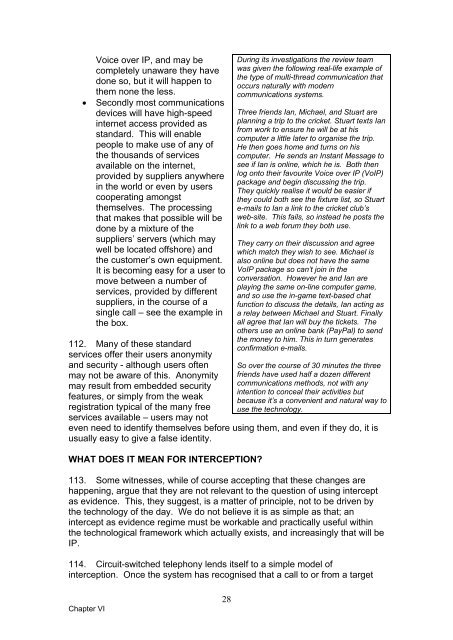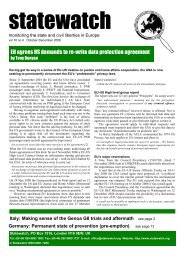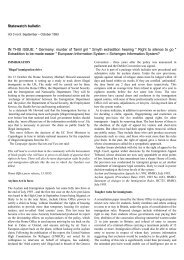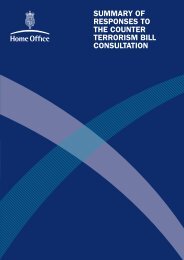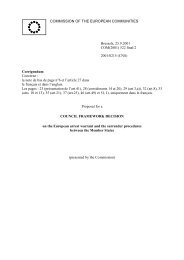Privy Council Review of intercept as evidence: report - Official ...
Privy Council Review of intercept as evidence: report - Official ...
Privy Council Review of intercept as evidence: report - Official ...
You also want an ePaper? Increase the reach of your titles
YUMPU automatically turns print PDFs into web optimized ePapers that Google loves.
Voice over IP, and may be<br />
completely unaware they have<br />
done so, but it will happen to<br />
them none the less.<br />
Secondly most communications<br />
devices will have high-speed<br />
internet access provided <strong>as</strong><br />
standard. This will enable<br />
people to make use <strong>of</strong> any <strong>of</strong><br />
the thousands <strong>of</strong> services<br />
available on the internet,<br />
provided by suppliers anywhere<br />
in the world or even by users<br />
cooperating amongst<br />
themselves. The processing<br />
that makes that possible will be<br />
done by a mixture <strong>of</strong> the<br />
suppliers’ servers (which may<br />
well be located <strong>of</strong>fshore) and<br />
the customer’s own equipment.<br />
It is becoming e<strong>as</strong>y for a user to<br />
move between a number <strong>of</strong><br />
services, provided by different<br />
suppliers, in the course <strong>of</strong> a<br />
single call – see the example in<br />
the box.<br />
112. Many <strong>of</strong> these standard<br />
services <strong>of</strong>fer their users anonymity<br />
and security - although users <strong>of</strong>ten<br />
may not be aware <strong>of</strong> this. Anonymity<br />
may result from embedded security<br />
features, or simply from the weak<br />
registration typical <strong>of</strong> the many free<br />
services available – users may not<br />
even need to identify themselves before using them, and even if they do, it is<br />
usually e<strong>as</strong>y to give a false identity.<br />
WHAT DOES IT MEAN FOR INTERCEPTION?<br />
During its investigations the review team<br />
w<strong>as</strong> given the following real-life example <strong>of</strong><br />
the type <strong>of</strong> multi-thread communication that<br />
occurs naturally with modern<br />
communications systems.<br />
Three friends Ian, Michael, and Stuart are<br />
planning a trip to the cricket. Stuart texts Ian<br />
from work to ensure he will be at his<br />
computer a little later to organise the trip.<br />
He then goes home and turns on his<br />
computer. He sends an Instant Message to<br />
see if Ian is online, which he is. Both then<br />
log onto their favourite Voice over IP (VoIP)<br />
package and begin discussing the trip.<br />
They quickly realise it would be e<strong>as</strong>ier if<br />
they could both see the fixture list, so Stuart<br />
e-mails to Ian a link to the cricket club’s<br />
web-site. This fails, so instead he posts the<br />
link to a web forum they both use.<br />
They carry on their discussion and agree<br />
which match they wish to see. Michael is<br />
also online but does not have the same<br />
VoIP package so can’t join in the<br />
conversation. However he and Ian are<br />
playing the same on-line computer game,<br />
and so use the in-game text-b<strong>as</strong>ed chat<br />
function to discuss the details, Ian acting <strong>as</strong><br />
a relay between Michael and Stuart. Finally<br />
all agree that Ian will buy the tickets. The<br />
others use an online bank (PayPal) to send<br />
the money to him. This in turn generates<br />
confirmation e-mails.<br />
So over the course <strong>of</strong> 30 minutes the three<br />
friends have used half a dozen different<br />
communications methods, not with any<br />
intention to conceal their activities but<br />
because it’s a convenient and natural way to<br />
use the technology.<br />
113. Some witnesses, while <strong>of</strong> course accepting that these changes are<br />
happening, argue that they are not relevant to the question <strong>of</strong> using <strong>intercept</strong><br />
<strong>as</strong> <strong>evidence</strong>. This, they suggest, is a matter <strong>of</strong> principle, not to be driven by<br />
the technology <strong>of</strong> the day. We do not believe it is <strong>as</strong> simple <strong>as</strong> that; an<br />
<strong>intercept</strong> <strong>as</strong> <strong>evidence</strong> regime must be workable and practically useful within<br />
the technological framework which actually exists, and incre<strong>as</strong>ingly that will be<br />
IP.<br />
114. Circuit-switched telephony lends itself to a simple model <strong>of</strong><br />
<strong>intercept</strong>ion. Once the system h<strong>as</strong> recognised that a call to or from a target<br />
Chapter VI<br />
28


